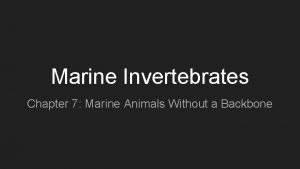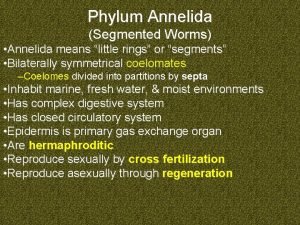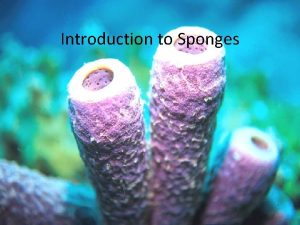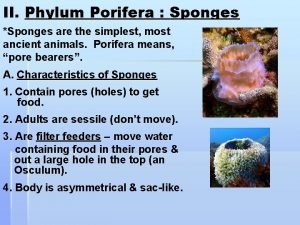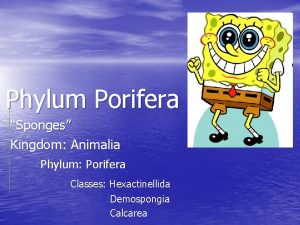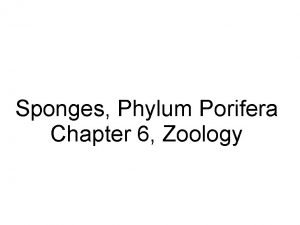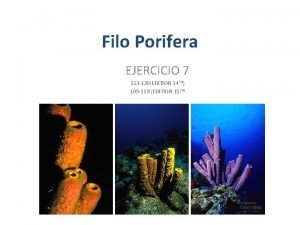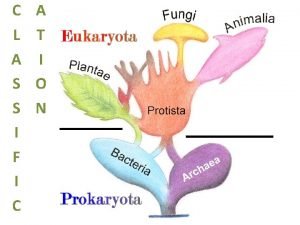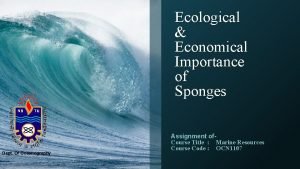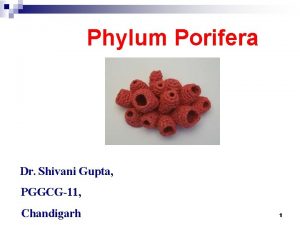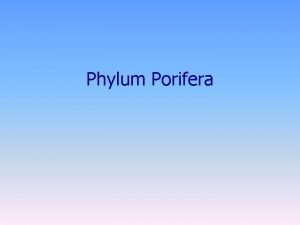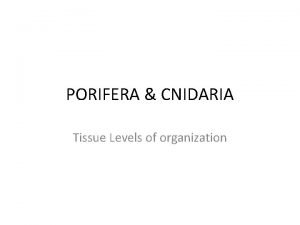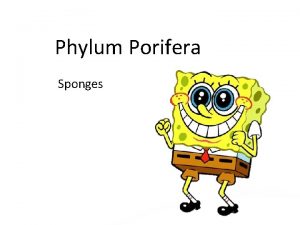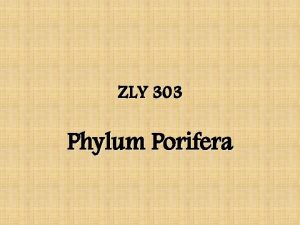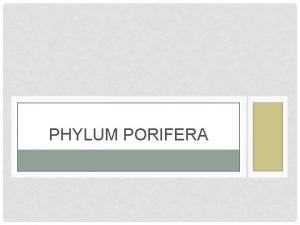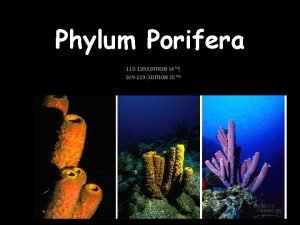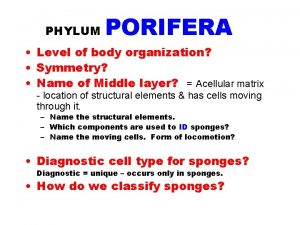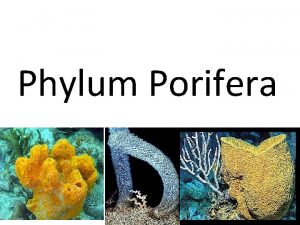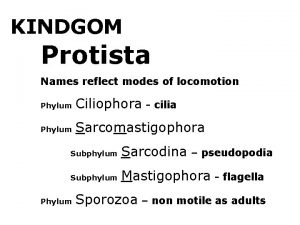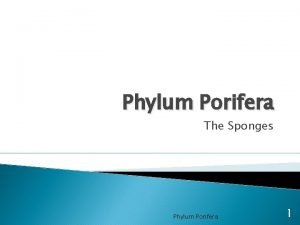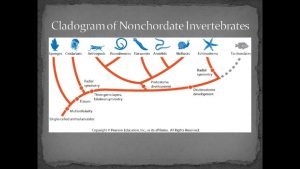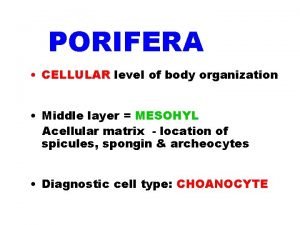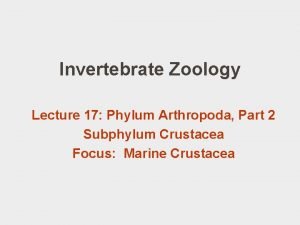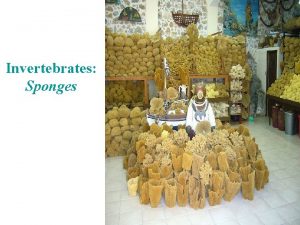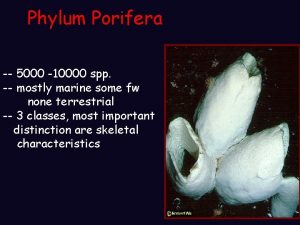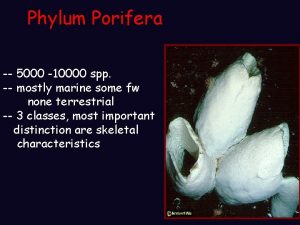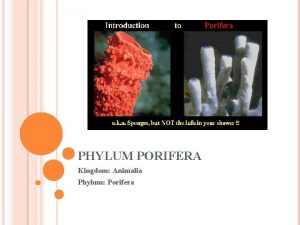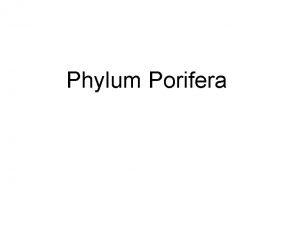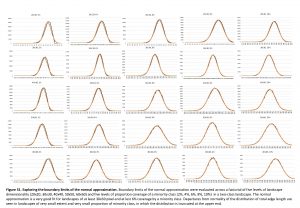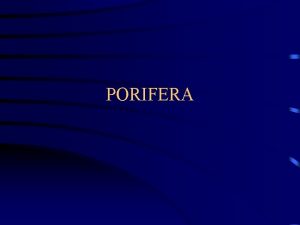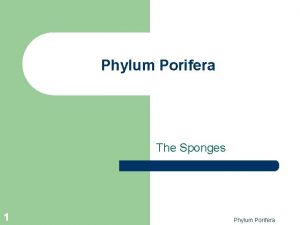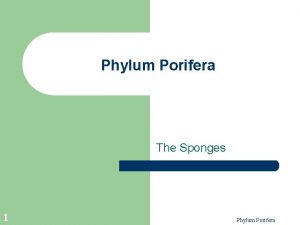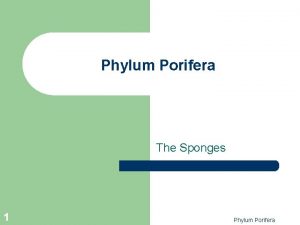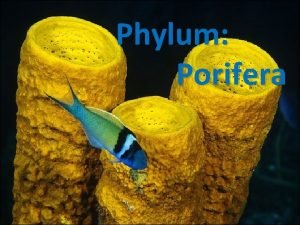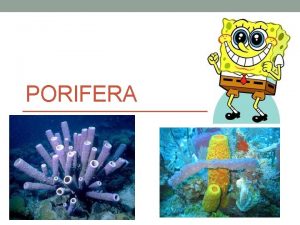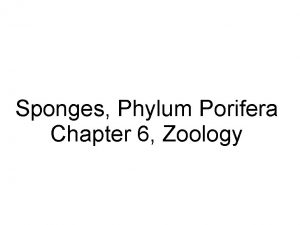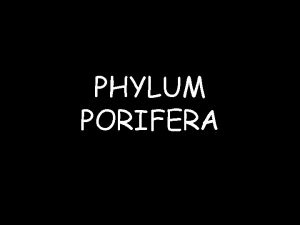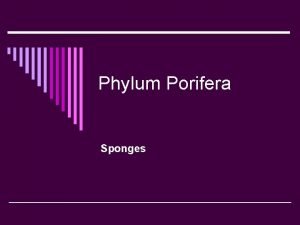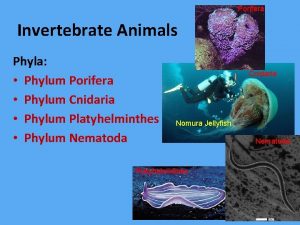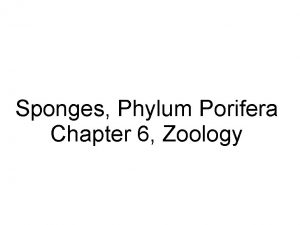Phylum Porifera 5000 10000 spp mostly marine some



























- Slides: 27

Phylum Porifera -- 5000 -10000 spp. -- mostly marine some fw none terrestrial -- 3 classes, most important distinction are skeletal characteristics

Phylum Porifera I. General Ecological Characteristics II. Body Plan III. Metazoan Characteristics A. Cell types B. Allorecognition C. Reproduction and Embryology D. Other metazoan homologies. IV. Sponge Phylogeny

I. General Ecological Characteristics Sponges are: • Sessile, benthic • Filter feeders • Competitors for space • Fed upon by specialist predators • Grow in many forms, solitary, colonial, branching, as thin sheets over substrates • From few cm to over 1 m in size • Estimated in some cases to be several hundred years old

II. General Characteristics of the Porifera Body Plan The classification of sponges is based on skeletal morphology

images. slideplayer. com

II. General Characteristics of the Poriferan Body Plan 3 major types of body construction Asconoid Syconoid Leuconoid (this has little to do with the classification of sponges, which is based on skeletal morphology)

Asconoid Sponge Syconoid Sponge

Osculum Ostia Leuconoid Arrangement These are the largest, and most sponges have this type of construction


Sponge Feeding Movie Simulations of Sponge Feeding http: //www. biology. ualberta. ca/facilities/multimedia/uploads/zoology/Porifera. swf http: //www. youtube. com/watch? v=R m. PTM 965 -1 c&feature=related

Carnivorous sponges from deep water and shallow caves Evolution of macrophagy from a microphagous, filter feeding life style

II. Other Characteristics of the Poriferan Body Plan • No true muscular system • Lacking sensory organs, nervous system • Often amorphous and asymmetrical, no anterior, posterior, oral surfaces • No true tissues • All physiological functions carried out at the cellular level Begs the question: Colony of protista or a simple metazoan (i. e. an integrated animal ? )

III. Metazoan-like Characteristics of Sponges A. 5 different principal cell types (20 total) Osculum Pinacocyte Choanocyte spongocoel Porocyte Sclerocytes Archeocyte http: //www. biology. ualberta. ca/facilities/multimedia/uploads/zoology/Porifera. swf

Stem cells – have the capacity of self-replication and to give rise to more than one type of mature daughter cells Image courtesy of Bio. MEDIA ASSOCIATES Archeocytes – in sponge embryos are considered totipotent stem cells that can give rise to an entire organism - in adults they produce a few cell types (sclerocytes, germ cells, etc. ) but not an entire organism; they are considered pluripotent Muller (2006) Seminars in Cell and Developmental Biology #17: 481 -491

III. Metazoan-like Characteristics of Sponges B. Complex reproduction

III. Metazoan-like Characteristics of Sponges Unique but complex embryonic development, with a hollow blastula stage but does not form a gastrula Carried in the plankton sperm Egg Parenchymula or Amphiblastula Settlement & metamorphosis Juvenile Adult Sexual reproduction involves fertilization, release of a planktonic larva, and its eventual settlement and metamorphosis on the bottom.

III. Metazoan-like Characteristics of Sponges C. Other sponge metazoan homologies: Epithelium -- pinacoderm: epithelial-like layer homologous to animal epithelia with collagenous sublayer (. . . but basal lamina only in Homoscleromorphs)… -- septate junctions (desmosomes) albeit primitive and small (only Calcarea has full “animal-like” desmosomes) -- extracellular matrix -- spongin is collagen-like molecule -- ubiquitin protein similarity (tag other proteins for proteolysis)

Integrative and Comparative Biology Advance Access published online on June 22, 2009 Integrative and Comparative Biology, doi: 10. 1093/icb/icp 038 Epithelia and integration in sponges Sally P. Leys 1, *, Scott A. Nichols{dagger} and Emily D. M. Adams* *Department of Biological Sciences, University of Alberta, Edmonton, AB, Canada T 6 G 2 E 9; {dagger}Department of Molecular and Cell Biology, University of California, Berkeley, CA 94720, USA Correspondence: 1 E-mail: sleys@ualberta. ca An epithelium is important for integrity, homeostasis, communication and co-ordination, and its development must have been a fundamental step in the evolution of modern metazoan body plans. Sponges are metazoans that are often said to lack a true epithelium. We assess the properties of epithelia, and review the history of studies on sponge epithelia, focusing on their homology to bilaterian epithelia, their ultrastructure, and on their ability to seal. Electron micrographs show that adherens-type junctions are present in sponges but they can appear much slighter than equivalent junctions in other metazoans. Fine septae are seen in junctions of all sponge groups, but distinct septate junctions are only known from Calcarea. Similarly, all sponges can have collagenous sheets underlying their epithelia, but only homoscleromorphs are established to have a distinct basal lamina. The presence of most, but not all, gene families known to be involved in epithelial development and function also suggests that sponge epithelia function like, and are homologous to, bilaterian epithelia. However, physiological evidence that sponge epithelia regulate their internal environment is so far lacking. Given that up to six differentiated epithelia can be recognized in sponges, distinct physiological roles are expected. Recognition that sponges have epithelia challenges the perception that sponges are only loose associations of cells, and helps to relate the biology and physiology of the body plan of the adult sponge to the biology of other metazoans.

III. Metazoan-like Characteristics of Sponges C. Other sponge metazoan homologies: Regulation of Development -- True Hox genes are not found, but many homologous developmental transcription factors are conserved -- Most of the developmental signaling pathways (Wnt, Notch) and they are expressed along the same embryonic “axis” in sponges (and Cnidaria). Many of these signaling pathways and transcription factors have not been found in Protists. From Adamaska et al. , 2011

III. Metazoan-like Characteristics of Sponges D. Non-self recognition “Allorecognition” Some sponges form new individuals hours after their cells are separated from one another. If species are combined, the cells segregate with their own

“Metazoan-like Characteristics of Sponges” Allorecognition Histoincompatability Immune response: antagonism toward foreign substances antagonism must be specific toward that substance future responses should be altered by the first response The sponge immune response is mediated by molecules which have been found to control histo-recognition in deuterostomes including Immunoglobulin-like domains and citokines

Summary -- Sponges lack complexity, but their body plan is ecologically and evolutionarily successful --They should be considered metazoans since they have fundamental characteristics of multicellular animals; --They are derived from flagellated protists but may be a early and now distant branch of the metazoa; animals are monophyletic

Phylum Placozoa -- 2 -3 mm, 25 um- thick, resembling a large ameba -- Lacks anterior posterior polarity -- Asexual reproduction is prevalent --The most primitive animal? Trichoplax adhaerens

Phylum Placozoa Dorsal epithelium-like layer Fiber synctium thick glandular layer Flagellated cells Intercellular junctions -- Feed ventrally by absorption of digested material -- Lack organs but tissue-like outer walls (no basement membrane) -- A bit more than 2000 cells -- Only 4 different cell types (20 in sponges; > 220 in mammals) -- Smallest genome of all animals cilium

Three competing Scenarios A. Earliest view of them as the basal metazoan B. Special cellular junctions consisting of two opposing dense plaques (desmosomes) not found in most sponges C. 16 S r. RNA data…maybe secondarily simplified from more complex ancestors?

Mitochondrial genome of Trichoplax adhaerens supports Placozoa as the basal lower metazoan phylum Dellaporta, Stephen L. et al. (2006) Proc. Natl. Acad. Sci. USA 103, 8751 -8756 Largest known mt genome 46 kbp, 2 x that of most metazoa with introns and other intrageneic spacers and large protein coding regions that are usually lacking in other animals Blue: known mt proteins Gray: ribosomal genes Green: unknown open reading frames Red lines: introns

(a sponge) Conclusions?
 Marine animals with soft bodies and no backbone crossword
Marine animals with soft bodies and no backbone crossword What phylum means little rings
What phylum means little rings Phylum porifera is classified based on
Phylum porifera is classified based on Characteristics of sponges
Characteristics of sponges Sponge animal
Sponge animal Mesohyl
Mesohyl Leucosolenia slide
Leucosolenia slide Examples of sponges invertebrates
Examples of sponges invertebrates Features of porifera
Features of porifera Importance of sponges
Importance of sponges Phylum porifera
Phylum porifera Porifera features
Porifera features Level of organization cnidarians
Level of organization cnidarians Phylum porifera body plan
Phylum porifera body plan Sponge spicules
Sponge spicules Phylum porifera questions
Phylum porifera questions Euplectella
Euplectella Porifera symmetry
Porifera symmetry Ascon leucon sycon
Ascon leucon sycon Foramnifera
Foramnifera Ostia-spongocoel-osculum
Ostia-spongocoel-osculum Porifera excretion
Porifera excretion Porifera cellular organization
Porifera cellular organization Phylum arthropoda marine
Phylum arthropoda marine What is tagmatization
What is tagmatization Sponges invertebrates
Sponges invertebrates They say it only takes a little faith to move a mountain
They say it only takes a little faith to move a mountain Some say the world will end in fire some say in ice
Some say the world will end in fire some say in ice
